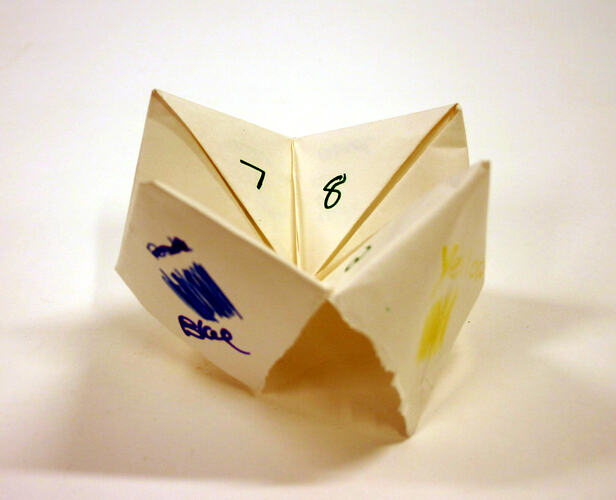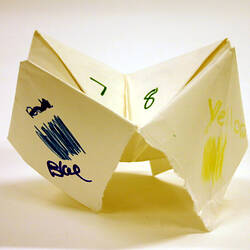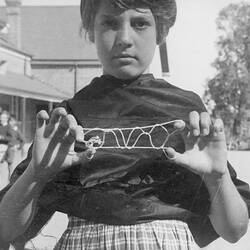Summary
This paper fortune teller, also known as a chatterbox, was folded by Scott Kenner, aged 8, Melbourne, 1992, and given to Judy McKinty. Donated by Judy McKinty, 1992.
This object is part of the Australian Children's Folklore Collection. The ACFC is unique in Australia, documenting contemporary children's folklore across Australia and in other countries, reaching back to the 1870s. The Collection has a strong component of research material relating to Victoria.
Prediction games feature strongly in children's folklore, as does the making of paper toys for fun and amusement. The two activities come together in the making and using of 'Fortune Tellers', a game which has been played by generations of Australian children. The toy usually doesn't have one specific name, but has sometimes been called 'Fortune Teller' to identify the activity. This game is one area of children's folklore where children can express themselves freely to adults. The 'fortunes' can at times be confronting to adults, so the choosing of an arbitrary number by an adult absolves the child from any blame associated with the use of terms or expressions which would not normally be said to adults. Adults usually accept this activity as a game, which they themselves might remember from their own childhood, and accept the rules.
Physical Description
Paper toy, folded from a square of white paper, Origami-style. The outside of the Fortune Teller has four square flaps, each with a patch of colour and the name of the colour written on it - colours are green, blue, pink and yellow. Inside, there are four triangular flaps, which are divided in half, and on each half a number is written in green felt pen. The numbers are from 1 to 8. Under the flap, a message, or fortune is written in green felt pen. The toy ismanipulated by placing fingers under the colour flaps, and opening and closing hands to reveal 4 numbers at a time. When someone chooses a number, the flap is lifted and the fortune told. Acknowledgement: Australian Children's Folklore Collection, Museum Victoria.
More Information
-
Collection Names
-
Collecting Areas
-
Acquisition Information
Cultural Gifts Donation from Dr June Factor, 18 May 1999
-
Acknowledgement
Donated through the Australian Government's Cultural Gifts Program.
-
Maker
Scott Kenner, Melbourne, Greater Melbourne, Victoria, Australia, 1992
-
Date Used
-
Inscriptions
On colour flaps: Green/Blue/Yellow/Pink On inside triangular flaps: 1/2/3/4/5/6/7/8 Underneath flaps: You love dogs/You love flowers/You are a Pretty Mouse/You are married/Kiss me/You Got(?) Halke(?)/You are nice/You are mad.
-
Classification
-
Category
-
Discipline
-
Type of item
-
overall dimensions
10.5 cm (Length), 1 cm (Width), 10.5 cm (Height)
-
Overall Dimensions - Folded
107 mm (Length), 105 mm (Width), 15 mm (Height)
Measurement From Conservation. dimensions as folded with numbers facing up.
-
Keywords
Amusements, Censorship, Children's Folklore, Children's Play, Paper Craft, Making History - Australian Childrens Folklore




